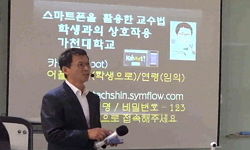본 연구는 웹기반 프로젝트학습에서 학습자간 상호작용과 학습실재감이 성취도와 만족도를 예측하는지 알아보기 위해서 15주 동안 프로젝트학습을 진행한 63명의 대학생을 대상으로 연구를...
http://chineseinput.net/에서 pinyin(병음)방식으로 중국어를 변환할 수 있습니다.
변환된 중국어를 복사하여 사용하시면 됩니다.
- 中文 을 입력하시려면 zhongwen을 입력하시고 space를누르시면됩니다.
- 北京 을 입력하시려면 beijing을 입력하시고 space를 누르시면 됩니다.

웹기반 프로젝트 학습에서 학습자 간 상호작용과 학습실재감이 학습성과에 미치는 영향 = The Effect of Interaction and Learning Presence on Learning Outcome in Web-Based Project Learning
한글로보기https://www.riss.kr/link?id=A76565356
- 저자
- 발행기관
- 학술지명
- 권호사항
-
발행연도
2009
-
작성언어
-
-
주제어
웹기반 프로젝트 학습 ; 상호작용 ; 학습실재감 ; 성취도 ; 만족도 ; Web-based project Learning ; interaction ; Learning presence ; achievement ; satisfaction
-
KDC
373.305
-
등재정보
KCI등재
-
자료형태
학술저널
-
수록면
67-85(19쪽)
-
KCI 피인용횟수
41
- 제공처
-
0
상세조회 -
0
다운로드
부가정보
국문 초록 (Abstract)
본 연구는 웹기반 프로젝트학습에서 학습자간 상호작용과 학습실재감이 성취도와 만족도를 예측하는지 알아보기 위해서 15주 동안 프로젝트학습을 진행한 63명의 대학생을 대상으로 연구를 진행하였다. 연구 결과 첫째, 학습자 간 상호작용은 β=.76로 성취도를 유의미하게 예측하는 변인으로 조사되었으나(t=9.15, p<.05), 만족도에 대한 예측은 유의미하지 않았다. 더 나아가 학습자 간 상호작용의 하위변인인 과제관련과 과제비관련 변인에 대해서 분석한 결과 학습자 간 상호작용은 그 유형과 관계없이 모두 성취도를 유의미하게 예측하는 것으로 조사 되었다. 둘째, 학습실재감은 β=.63로 만족도를 유의미하게 예측하였으나(t=6.35, p<.05), 성취도에 대한 예측은 유의미하지 않았다. 또한 인지적, 감성적, 사회적 실재감으로 분류된 학습실재감 하위요인 중 인지적실재감만이 β=.70으로 만족도를 유의하게 예측하는 것으로 분석되었다(t=7.74, p<.05).
다국어 초록 (Multilingual Abstract)
To investigate the influence of learner interaction and perceived presence level on the outcomes of learning, this study sampled 63 undergraduate students enrolled in a Web-based project course which lasted for 15 weeks. The numbers of task-related an...
To investigate the influence of learner interaction and perceived presence level on the outcomes of learning, this study sampled 63 undergraduate students enrolled in a Web-based project course which lasted for 15 weeks. The numbers of task-related and task-not-related interaction in student messages were counted by sentence-unit. Perceived learning presence composed of cognitive, social, and emotional level was assessed by self-report items. Learning outcomes were gathered in terms of achievement and satisfaction. Followings are the results: (1) Total interaction significantly predicted achievement, β=.76 (t=9.15, p<.05), but not satisfaction. (2) Task-related interaction significantly predicted achievement, β=.40 (t=3.69, p<.05), and so did task-not-related interaction, β=.45 (t=4.23, p<.05). (3) Learning presence significantly predicted satisfaction, β=.63 (t=6.35, p<.05), but not achievement. (4) Among the sub-factors of learning presence, only cognitive presence significantly predicted satisfaction, β=.70 (t=7.74, p<.05), but not social and emotional presence. These results indicated that interaction and learning presence could be critical factors to improve learning outcomes in Web-based project learning. Details on the predictive power of each sub-factors could be used as the basis of future instructional design.
참고문헌 (Reference)
1 강명희, "웹기반 문제중심학습에서 학습결과를 예측하는 요인 규명" 교육과학연구소 39 (39): 107-134, 2008
2 임정훈, "웹기반 가상수업에서 온라인 토론 촉진을 위한 설계전략" 37 (37): 249-270, 1999
3 정인성, "열린원격교육과 정보통신공학" 14 (14): 163-186, 1998
4 양병화, "다변량 자료분석의 이해와 활용" 학지사 1998
5 Moore,M, "types of interaction. In Distance Education: New Perspectives" Routledge 1993
6 Swan,K, "Virtual interaction: design factors affecting student satisfaction and perceived learning in asynchronous online courses" 22 (22): 306-331, 2001
7 Morgan,A, "Theoretical aspects of project-based learning in higher education" 1 : 66-78, 1983
8 Tu, C. H, "The relationship of social presence and interaction in online classes" 16 (16): 131-150, 2002
9 Hare, A. P, "Social interaction in Small group research: A handbook" Ablex 1994
10 Stacey,E, "Quality online participation: Establishing social presence" 138-153, 2002
1 강명희, "웹기반 문제중심학습에서 학습결과를 예측하는 요인 규명" 교육과학연구소 39 (39): 107-134, 2008
2 임정훈, "웹기반 가상수업에서 온라인 토론 촉진을 위한 설계전략" 37 (37): 249-270, 1999
3 정인성, "열린원격교육과 정보통신공학" 14 (14): 163-186, 1998
4 양병화, "다변량 자료분석의 이해와 활용" 학지사 1998
5 Moore,M, "types of interaction. In Distance Education: New Perspectives" Routledge 1993
6 Swan,K, "Virtual interaction: design factors affecting student satisfaction and perceived learning in asynchronous online courses" 22 (22): 306-331, 2001
7 Morgan,A, "Theoretical aspects of project-based learning in higher education" 1 : 66-78, 1983
8 Tu, C. H, "The relationship of social presence and interaction in online classes" 16 (16): 131-150, 2002
9 Hare, A. P, "Social interaction in Small group research: A handbook" Ablex 1994
10 Stacey,E, "Quality online participation: Establishing social presence" 138-153, 2002
11 Blumenfeld, P. C, "Motivating project-based learning: Sustaining the doing, supporting the learning" 26 (26): 369-398, 1991
12 Martinez,M, "High attrition rates in e-Learning: Challenges, predictors, and solutions" 1-9, 2003
13 Hartman, J. L, "Factors related to the satisfaction of faculty teaching online courses at the University of Central Florida" 2001
14 Richardson, J. C, "Examining social presence in online coursesin relation to students' perceived learning and satisfaction" 7 (7): 68-88, 2003
15 Kim,N.R, "Effects of facilitation promoting cognitive presence on student learning and satisfaction in an online community of inquiry" 10-, 2007
16 Campbell, P, "Educational presence in the community inquiry model: The student's viewpoint" 2024
17 Barron,B.J.S, "Doing with understanding: Lessons from research on problem- and project-based learning" 7 (7): 271-311, 1998
18 Cutler,R.H, "Distributed presence and community in cyberspace" 3 (3): 1995
19 Kang, M. H, "Developing a social presence scale for measuring students' involvement" 2007
20 Wang, M., J, "Cybergogy for engaged learning: A framework for creating learner engagement through information and communication technology. In Engaged Learning with Emerging Technologies" pringer Publishing. 225-253, 2006
21 Garrison, D. R, "Critical thinking and computer conferencing: A model and tool to assess cognitive presence" 15 (15): 7-23, 2001
22 Varnhagen, S, "Comparison of Student Experiences with Different Online Graduate Courses in Health Promotion" 31 (31): 99-119, 2005
23 Veerman, A, "Collaborative learning through computer-mediated communication in academic education"
24 Swan, K., "Building knowledge building communities: Consistency, contact and communication in the virtual classroom" 23 (23): 389-413, 2000
25 Picciano,A.G, "Beyond student perceptions: issues of interaction, presence, and performance in an online course" 6 (6): 21-40, 2002
동일학술지(권/호) 다른 논문
-
교수 가이던스 관점에서 디지털교과서 활용유형이 수학과 학습효과에 미치는 영향
- 한국교육정보미디어학회
- 송해덕 ( Hae Deok Song )
- 2009
- KCI등재
-
사이버가정학습체제 학습관리시스템의 상호작용 지원 기능 분석
- 한국교육정보미디어학회
- 엄우용 ( Woo Yong Eom )
- 2009
- KCI등재
-
온라인 사례기반학습에서 사례의 구성방식과 추론활동 지원도구의 제공에 따른 효과 분석
- 한국교육정보미디어학회
- 임영택 ( Young Taek Lim )
- 2009
- KCI등재
-
이러닝 학습환경에서 텍스트 구조 파악 및 내용 이해 촉진을 위한 텍스트 정보 구조의 시각적 설계전략 개발 및 효과성 연구
- 한국교육정보미디어학회
- 성은모 ( Eun Mo Sung )
- 2009
- KCI등재
분석정보
인용정보 인용지수 설명보기
학술지 이력
| 연월일 | 이력구분 | 이력상세 | 등재구분 |
|---|---|---|---|
| 2026 | 평가예정 | 재인증평가 신청대상 (재인증) | |
| 2020-04-20 | 학회명변경 | 영문명 : Korea Association Of Educational Information & Broadcasting -> Korea Association for Educational Information and Media |  |
| 2020-01-01 | 평가 | 등재학술지 유지 (재인증) |  |
| 2017-01-01 | 평가 | 등재학술지 유지 (계속평가) |  |
| 2013-01-01 | 평가 | 등재학술지 유지 (등재유지) |  |
| 2010-01-01 | 평가 | 등재학술지 유지 (등재유지) |  |
| 2008-01-01 | 평가 | 등재학술지 유지 (등재유지) |  |
| 2005-01-01 | 평가 | 등재학술지 선정 (등재후보2차) |  |
| 2004-01-01 | 평가 | 등재후보 1차 PASS (등재후보1차) |  |
| 2003-01-01 | 평가 | 등재후보 1차 FAIL (등재후보1차) |  |
| 2001-07-01 | 평가 | 등재후보학술지 선정 (신규평가) |  |
학술지 인용정보
| 기준연도 | WOS-KCI 통합IF(2년) | KCIF(2년) | KCIF(3년) |
|---|---|---|---|
| 2016 | 1.59 | 1.59 | 1.95 |
| KCIF(4년) | KCIF(5년) | 중심성지수(3년) | 즉시성지수 |
| 2 | 1.96 | 2.299 | 0.35 |





 KCI
KCI KISS
KISS






